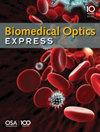用于荧光引导脑肿瘤切除术中高光谱图像稀疏非混合的光谱库和方法
IF 2.9
2区 医学
Q2 BIOCHEMICAL RESEARCH METHODS
引用次数: 0
摘要
通过光谱非混合,荧光引导脑肿瘤手术中的高光谱成像(HSI)能够对人眼看不到的肿瘤区域进行检测和分类。之前的解混合工作主要集中在确定一组已知存在于大脑中的最小可行荧光团光谱,并在不过度拟合的情况下有效地重建人类数据。对于这些内含物,通常使用非负最小二乘回归(NNLS)来计算丰度。然而,人脸图像是异质的,因此一小组内元光谱可能无法很好地拟合所有像素。此外,只有当测量值呈正态分布时,NNLS 才是最大似然估计法,而且它并不强制执行稀疏性,这就导致了过度拟合和非物理结果。在本文中,我们分析了来自 891 例不同脑肿瘤患者体内外测量的 555666 个 HSI 荧光光谱,结果表明,就 Kullback-Leibler 分歧而言,泊松分布对测量数据的建模效果确实比高斯分布好 82%,而且内含物丰度向量是稀疏的。有鉴于此,我们引入了:(1)一个包含 9 个内含成分的光谱库,其中包括 PpIX(620 nm 和 634 nm 光定态)、NADH、FAD、黄素、脂褐素、黑色素、弹性蛋白和胶原蛋白;(2)一个稀疏、非负泊松回归算法,利用这个光谱库进行物理信息的非混合,而不会出现过拟合;以及(3)一个高度真实的光谱测量模拟,其中包含已知的内含成分丰度。然后在人类数据和模拟数据上对新的解混合方法进行了测试,并与其他四种候选方法进行了比较。该方法优于之前的方法,在模拟数据上的计算丰度误差比 NNLS 低 25%,在人类数据上的重建误差更低,稀疏性更好,运行时间比最先进的泊松回归法快 31 倍。这种方法和内元光谱库可以实现更精确的光谱解混合,从而在脑肿瘤切除术中更好地帮助外科医生。本文章由计算机程序翻译,如有差异,请以英文原文为准。
Spectral library and method for sparse unmixing of hyperspectral images in fluorescence guided resection of brain tumors
Through spectral unmixing, hyperspectral imaging (HSI) in fluorescence-guided brain tumor surgery has enabled the detection and classification of tumor regions invisible to the human eye. Prior unmixing work has focused on determining a minimal set of viable fluorophore spectra known to be present in the brain and effectively reconstructing human data without overfitting. With these endmembers, non-negative least squares regression (NNLS) was commonly used to compute the abundances. However, HSI images are heterogeneous, so one small set of endmember spectra may not fit all pixels well. Additionally, NNLS is the maximum likelihood estimator only if the measurement is normally distributed, and it does not enforce sparsity, which leads to overfitting and unphysical results. In this paper, we analyzed 555666 HSI fluorescence spectra from 891 ex vivo measurements of patients with various brain tumors to show that a Poisson distribution indeed models the measured data 82% better than a Gaussian in terms of the Kullback-Leibler divergence, and that the endmember abundance vectors are sparse. With this knowledge, we introduce (1) a library of 9 endmember spectra, including PpIX (620 nm and 634 nm photostates), NADH, FAD, flavins, lipofuscin, melanin, elastin, and collagen, (2) a sparse, non-negative Poisson regression algorithm to perform physics-informed unmixing with this library without overfitting, and (3) a highly realistic spectral measurement simulation with known endmember abundances. The new unmixing method was then tested on the human and simulated data and compared to four other candidate methods. It outperforms previous methods with 25% lower error in the computed abundances on the simulated data than NNLS, lower reconstruction error on human data, better sparsity, and 31 times faster runtime than state-of-the-art Poisson regression. This method and library of endmember spectra can enable more accurate spectral unmixing to aid the surgeon better during brain tumor resection.
求助全文
通过发布文献求助,成功后即可免费获取论文全文。
去求助
来源期刊

Biomedical optics express
BIOCHEMICAL RESEARCH METHODS-OPTICS
CiteScore
6.80
自引率
11.80%
发文量
633
审稿时长
1 months
期刊介绍:
The journal''s scope encompasses fundamental research, technology development, biomedical studies and clinical applications. BOEx focuses on the leading edge topics in the field, including:
Tissue optics and spectroscopy
Novel microscopies
Optical coherence tomography
Diffuse and fluorescence tomography
Photoacoustic and multimodal imaging
Molecular imaging and therapies
Nanophotonic biosensing
Optical biophysics/photobiology
Microfluidic optical devices
Vision research.
 求助内容:
求助内容: 应助结果提醒方式:
应助结果提醒方式:


